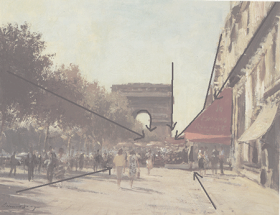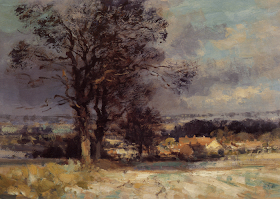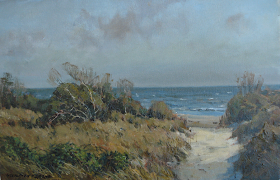 Whistler, "Little white girl" image: artrenewal.org
Whistler, "Little white girl" image: artrenewal.orgUsually I choose a subject and beat on it for a week or so. However yesterday I was checking out the prices of paint at the big mail order art suppliers and I noticed the prices on some of the common whites had gone up. So I think I will give you some advice on white. What follows is only an opinion, but some surprising things stood out at me so much that I decided to write this post.
I will restrict this discussion to titanium whites. I am fond of Flake (lead ) white but it is growing harder to find and I am reticent to advise you to use lead, as it is poisonous. A lot of your colors are poisonous but lead has been the focus of so much attention I will leave it out of our discussion for now. I personally think the very best white is about 2 parts flake with about 1 part titanium.
I buy my paint from RGH. A link to their site is in my sidebar. They are a very small paint maker in Albany, New York. I like their paint and it is affordable. I buy it in big cans and tube my own. If you want to know more about that, in the first month of this blog I did a a post on tubing paint. The first thirty or so posts were on materials. I am attempting to download what I know about painting onto this blog and it seemed sensible to begin with materials.
Since most of you buy your paint in tubes.That is what I am going to examine now. I recommend Jerrys artarama , but there are other fine mail order houses selling paint also. I do not recommend your buying paint from the mall outlets and craft supply stores. They are often 40 to 50% more expensive than mail order even after you figure in your shipping. The prices I am using in this post are from Jerrys. I don't think you will find other suppliers significantly cheaper on many things. If you do, let me know, please.
There are a bunch of different paints available and I think all of the professional lines are acceptable. None of the student grades are. Within the field of professional quality paints there is a range from good to super premium. There are also different tastes in paint. I will tell you what I like in titanium's and the one brand that stands out to me as a great bargain.
Old Holland, 125 mls costs $26.73 or about 21 cents a ml. That's a very high quality and expensive super premium paint. I won't spend that. If you can, this is a great white. I personally find Old Holland paint to actually have more pigment in it than I want. I like a looser paint. That is definitely a matter of opinion and many would disagree with me on that.
Rembrandt titanium costs $16.58 for a 150 ml. tube or 11 cents a ml. I personally don't like this white, it seems too fluffy to me. Like its whipped or something. I like their other colors but not their white.
Winsor and Newton costs $21.60 for 200 mls. or 10 cents a ml. that's a good price for an excellent white. I would say thats a great choice at its current price.
Gamblin cost $20.21 cents for 150 ml. tube That's 13 cents per ml. I can't see why you would choose this over the Winsor Newton . I think of Gamblin as being a professional quality paint but not so fine that I would pay a premium to have it, rather than Winsor Newton. Perhaps you know something I don't, am I missing something? Let me know in the comments if you think I am.
Blockx titanium costs $52.65 for a 200 ml. tube or 26 cents a mil. What are they kidding? If you are married to a thoracic surgeon this might be a good paint for you. But I wont spend over $ 50.00 a tube for white. I use a lot of white.
Grumbachers, soft titanium white is $13.26 for a 150 ml. tube or 8 cents a ml. That's a great buy on a classic paint that once owned the American market. Good buy. But not tonight's big winner.
Weber Permalba white is $8.49 for a 150 ml. tube or 5 cents a ml. That's a pretty good deal too, but not everybody is going to like Permalba. I think of it as a novelty act. It has a peculiar stringy (long) handling that I sometimes like and sometimes hate. You may want to try a tube and see if you like it. It has been around a long time and some fine painters have loved it. Odd stuff, weird plastic tube that I KNOW I don't like. It can be bought in quantity for an even better price. If price is your top consideration Permalba is for you. It works and it is a quality paint for a very low price.
Sennelier Extra Fine sells for $29.29 for a 200 ml. tube That works out to 14 and1/2 cents a ml. This is a nice white and I am as I said, fond of French paint however, it costs three times as much as the next paint on my list, which is tonight's winner of the Stapleton Kearns blogs' authors' choice award.
Lefranc & Bourgeois titanium white costs $13.70 for a 250 ml. tube
That works out to about 5 and1/2 cents a ml. I think this is a great buy. I like it better than any other white on this list at any price. This stuff has the greatest handling of any white, in my opinion. Now keep in mind I like a French style white, that is a somewhat oily, slippery white. I like the look of the brushwork I get from this paint. I think this is the white to use and it is sold at a great price besides. I recommend you use Lefranc and Bourgeois titanium white.
I am going to do another critique of a readers image, so please send me an image of something you have made, I will probably choose a landscape, but not necessarily, lets see what you've got. You can send it to me at stapletonkearns@gmail.com. I will photoshop your signature off of the piece and I will tell no one whose work I am critiquing.
See you all tomorrow.
















































